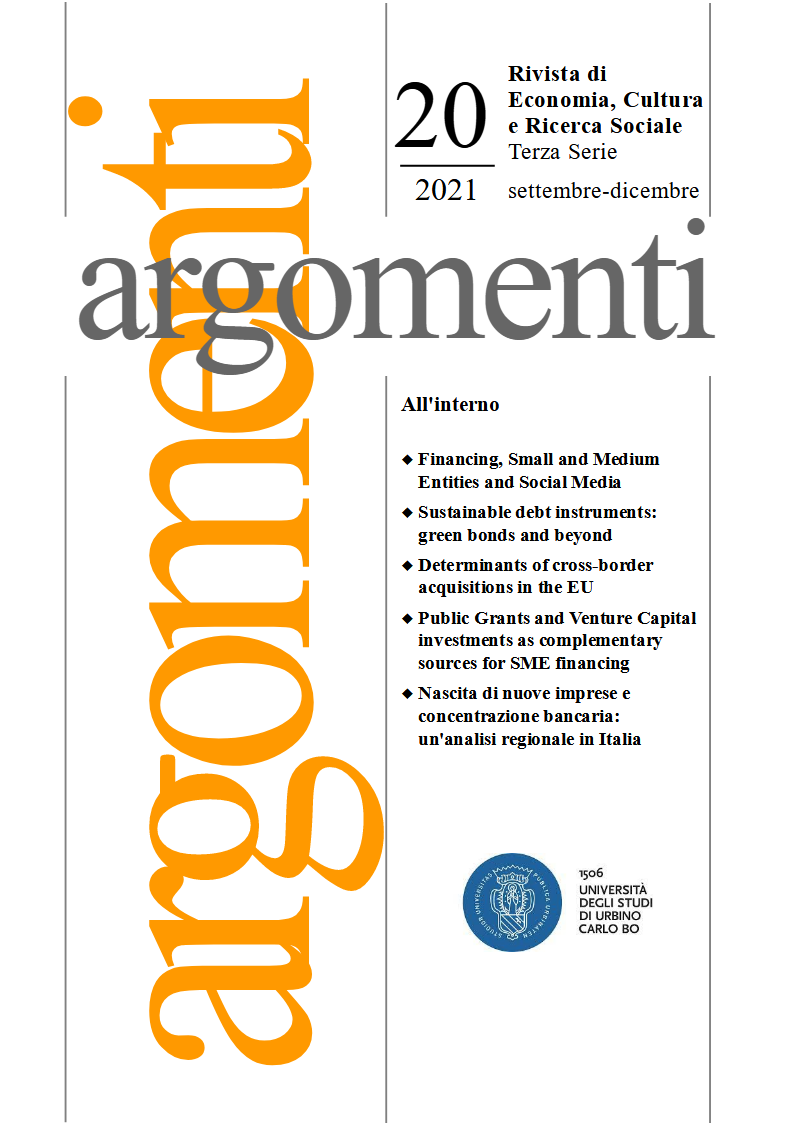Abstract
This article examines the relationship between corporate social media communication and financing for Small and Medium Entities (SMEs). First, it provides a critical analysis of prior literature on the use of corporate social media and the potential benefit and costs for SMEs. It then discusses current evidence on the relationship between corporate social media, the cost of equity and the cost of debt. Next, it provides empirical evidence on the impact of corporate social media use on the cost of debt for a set of small and medium firms listed on the Alternative Investment Market London. Lastly, it proposes future research avenues about the association between corporate social media communication and corporate financing. This study provides important theoretical and empirical evidence on how social media are revolutionizing corporate disclosure and the important implications for SMEs and their financing.
Riferimenti bibliografici
Acharya, V., Pagano, M., & Volpin, P. (2016). Seeking alpha: Excess risk taking and competition for managerial talent. The Review of Financial Studies, 29(10), 2565-2599.
Al Guindy, M. (2021). Corporate Twitter use and cost of equity capital. Journal of corporate finance, 68, 101926.
Alalwan, A. A., Rana, N. P., Dwivedi, Y. K., & Algharabat, R. (2017). Social media in marketing: A review and analysis of the existing literature. Telematics and Informatics, 34(7), 1177-1190.
Appel, G., Grewal, L., Hadi, R., & Stephen, A. T. (2020). The future of social media in marketing. Journal of the Academy of Marketing Science, 48(1), 79-95.
Bartov, E., Faurel, L., & Mohanram, P. S. (2018). Can Twitter help predict firm-level earnings and stock returns? The Accounting Review, 93(3), 25-57.
Beck, T., & Demirguc-Kunt, A. (2006). Small and medium-size enterprises: Access to finance as a growth constraint. Journal of Banking & finance, 30(11), 2931-2943.
Beck, T., Demirgüç-Kunt, A., & Maksimovic, V. (2008). Financing patterns around the world: Are small firms different? Journal of financial economics, 89(3), 467-487.
Blankespoor, E. (2018). Firm communication and investor response: A framework and discussion integrating social media. Accounting, Organizations and Society, 68, 80-87.
Blankespoor, E., Miller, G. S., & White, H. D. (2014). The role of dissemination in market liquidity: Evidence from firms' use of Twitter™. The Accounting Review, 89(1), 79-112.
Bougrain, F., & Haudeville, B. (2002). Innovation, collaboration and SMEs internal research capacities. Research policy, 31(5), 735-747.
Boulland, R., Filip, A., Ghio, A., & Paugam, L. (2021). Grabbing Investors’ Attention with Limited Resources: An Exploratory Study of the Small Cap Firms’ Communication Channels. working paper.
Bushee, B. J., & Miller, G. S. (2012). Investor relations, firm visibility, and investor following. The Accounting Review, 87(3), 867-897.
Cade, N. L. (2018). Corporate social media: How two-way disclosure channels influence investors. Accounting, Organizations and Society, 68, 63-79.
Ding, R., Zhou, H., & Li, Y. (2020). Social media, financial reporting opacity, and return comovement: Evidence from Seeking Alpha. Journal of Financial Markets, 50, 100511.
Elliott, W. B., Grant, S. M., & Hodge, F. D. (2018). Negative news and investor trust: The role of $ Firm and# CEO Twitter use. Journal of Accounting Research, 56(5), 1483-1519.
Fehrenbacher, D., & Ghio, A. (2021). Does Social Media Activity Influence Trade Credit Levels? Archival and Experimental Evidence. working paper.
Filip, A., Ghio, A., & Paugam, L. (2020). Accounting information in innovative small cap firms: evidence from London’s alternative investment market. Accounting and Business Research, 1-36.
Gerakos, J., Lang, M., & Matfett, M. (2013). Post-listing performance and private sector regulation: The experience of London's Alternative Investment Market. Journal of Accounting & Economics, 56(2-3), 189-215.
Ghio, A., & Verona, R. (2020). The Evolution of Corporate Disclosure: Insights on Traditional and Modern Corporate Communication. Springer.
Gómez-Carrasco, P., Guillamón-Saorín, E., & Garcia Osma, B. (2021). Stakeholders versus firm communication in social media: the case of Twitter and corporate social responsibility information. European Accounting Review, 30(1), 31-62.
Holmes, S., Dunstan, K., & Dwyer, D. (1994). The cost of debt for small firms: evidence from Australia. Journal of Small Business Management, 32(1), 27.
Jia, W., Redigolo, G., Shu, S., & Zhao, J. (2020). Can social media distort price discovery? Evidence from merger rumors. Journal of Accounting and Economics, 70(1), 101334.
Jung, M. J., Naughton, J. P., Tahoun, A., & Wang, C. (2018). Do firms strategically disseminate? Evidence from corporate use of social media. The Accounting Review, 93(4), 225-252.
Kaplan, A. M., & Haenlein, M. (2010). Users of the world, unite! The challenges and opportunities of Social Media. Business horizons, 53(1), 59-68.
Lee, L. F., Hutton, A. P., & Shu, S. (2015). The role of social media in the capital market: Evidence from consumer product recalls. Journal of Accounting Research, 53(2), 367-404.
Leiponen, A., & Byma, J. (2009). If you cannot block, you better run: Small firms, cooperative innovation, and appropriation strategies. Research policy, 38(9), 1478-1488.
Lerman, A. (2020). Individual Investors' Attention to Accounting Information: Evidence from Online Financial Communities. Contemporary Accounting Research, 37(4), 2020-2057.
López-Gracia, J., & Sogorb-Mira, F. (2008). Testing trade-off and pecking order theories financing SMEs. Small Business Economics, 31(2), 117-136.
Miller, G. S., & Skinner, D. J. (2015). The evolving disclosure landscape: How changes in technology, the media, and capital markets are affecting disclosure. Journal of Accounting Research, 53(2), 221-239.
Valta, P. (2012). Competition and the cost of debt. Journal of financial economics, 105(3), 661-682.

TQuesto lavoro è fornito con la licenza Creative Commons Attribuzione 4.0 Internazionale.
Copyright (c) 2021 Alessandro Ghio





